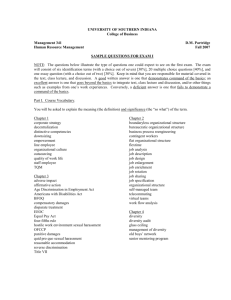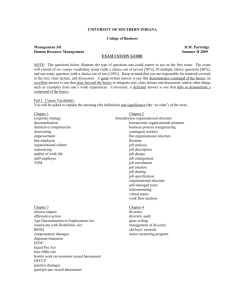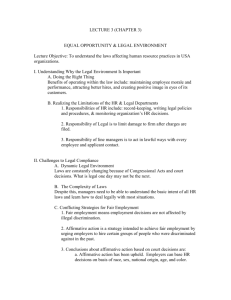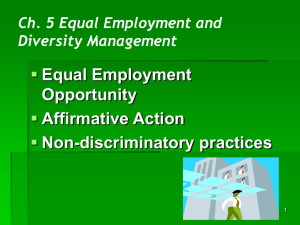Chapter 19
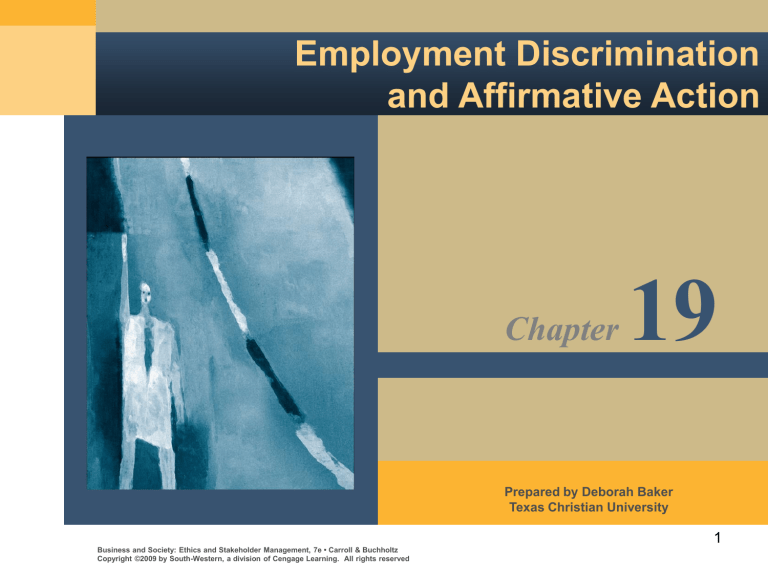
Employment Discrimination and Affirmative Action
Chapter
19
Business and Society: Ethics and Stakeholder Management, 7e • Carroll & Buchholtz
Copyright ©2009 by South-Western, a division of Cengage Learning. All rights reserved
Prepared by Deborah Baker
Texas Christian University
1
Chapter 19 Learning Outcomes
1.
Chronicle the U.S. civil rights movement and minority progress for the past 50 years.
2.
Outline the essentials of the federal discrimination laws.
3.
Provide two different meanings of discrimination and give examples of how each might be committed.
4.
Elaborate on employment discrimination relating to race, color, national origin, sex, age, religion, sexual orientation, and disability.
5.
Identify different postures with respect to affirmative action, explain the concept of reverse discrimination, and provide an overview of the Supreme Court’s decisions on affirmative action.
2
Chapter 19 Outline
The Civil Rights Movement and Minority Progress
Federal Laws Prohibiting Discrimination
Expanded Meanings of Discrimination
Issues in Employment Discrimination
Affirmative Action in the Workplace
Summary
Key Terms
Discussion Questions
3
Introduction to Chapter 19
The chapter addresses certain workplace rights:
Civil rights movement and minority progress
Federal discrimination laws
Affirmative action
4
Civil Rights Movement
The Civil Rights Act of 1964 was the effective beginning of the employee protection movement.
The 1970s:
The Women’s Movement
The 1980s: Gains for women and blacks
The 1990s: Some progress, but problems remained
The 2000s: New challenges and old problems
5
Federal Anti-Discrimination Laws
Title VII of the Civil Rights Act of 1964: Prohibits discrimination in hiring and other aspects of employment on the basis of race, color, religion, sex, or national origin.
Age Discrimination in Employment Act of 1967: Protects workers 40 years old and older from arbitrary age discrimination.
Equal Pay Act of 1963: Prohibits sex discrimination in payment of wages to women and men who perform substantially equal work.
Rehabilitation Act of 1973, Section 503: Prohibits job discrimination on the basis of a handicap.
Americans with Disabilities Act of 1990: Gives individuals with disabilities civil rights protections similar to those given to individuals on the basis of race, sex, national origin, and religion.
Civil Rights Act of 1991: Provided increased financial damages and jury trials in cases of intentional discrimination.
6
Title VII of the Civil Rights Act of 1964
It is illegal under Title VII to discriminate in:
Hiring and firing
Compensation, assignment, or classification of employees
Transfer, promotion, layoff, or recall
Job advertisements
Recruitment
Testing
Use of company facilities
Training and apprenticeship programs
Fringe benefits
Pay, retirement plans, and disability leave
Other terms and conditions of employment
7
Americans with Disabilities Act
An individual with a disability…
Has a physical or mental impairment that limits one or more major life activities,
Has a record of such an impairment, or
Is regarded as having such an impairment.
Reasonable accommodation may include:
Accessible facilities
Job restructuring, work schedule modification, reassignment
Acquiring or modifying equipment or devices; making adjustments to examinations; providing training materials, readers, or interpreters
8
Federal Anti-Discrimination Laws
Equal Opportunity Commission (EEOC)
Five Commissioners
• President appoints and Senate confirms
Purpose
• Makes equal employment opportunity policy
• Investigates employment discrimination complaints
• Enforces anti-discrimination laws
9
Disparate Treatment and Impact
Disparate
Treatment
Using race, color, religion, sex, or national origin as a basis for treating people differently or unequally
Disparate
Impact
Fewer minorities are included in the outcome of testing, hiring, or promotion practices than would be expected by numerical proportion
10
Employment Discrimination
Disparate Treatment
Direct discrimination
Disparate Impact
Indirect discrimination
Unequal treatment
Decision rules with a racial /sexual premise
Intentional discrimination
Unequal consequences or results
Decision rules with racial / sexual consequences
Unintentional discrimination
Prejudiced actions
Different standards for different groups
Figure 19-5
Neutral, color-blind actions
Same standards, but different consequences for different groups
11
Issues in Racial Discrimination
Five Racial Categories
1. American Indian or Alaska native
2. Asian
3. Black or African
American
4. Native Hawaiian or Other Pacific Islander
5. White
One Ethnicity Category
1. Hispanic or Latino
@ https://implicit.harvard.edu/implicit
12
Issues in Racial Discrimination
The Two Nations of Black America
The Case of Hispanics
Asian Image of Model Minority
13
Issues of Sex Discrimination
Major Issues for Women
1.
Getting into professional and managerial positions and out of traditional female-dominated positions
2.
Achieving pay commensurate with that of men
3.
Eliminating sexual harassment
• Quid pro quo
• Hostile work environment
4.
Being able to take maternity leave without losing jobs
14
Pay Equity
Possible Causes of Pay Discrepancy for Women
Lose time and experience through extended maternity leave
Leave the workplace for longer periods of time
Employed at lower paying jobs
Women’s hesitation to negotiate
• Socialized not to negotiate from a young age
• Rewards for men can result in penalties for women
15
Sexual Harassment
Unwelcome sexual advances, requests for sexual favors, and other verbal or physical conduct of a sexual nature when submission to or rejection of this conduct affects an individual’s employment, interferes with an individual’s work performance, or creates an intimidating, hostile, or offensive work environment.
16
Types of Sexual Harassment
Quid Pro Quo
Something is given or received for something else.
Hostile Work
Environment
The employee perceives a hostile or offensive work environment by virtue of uninvited sexually oriented behaviors or materials present in the workplace.
17
Sexual Harassment
Circumstances
The victim as well as the harasser may be a woman or a man. The victim does not have to be of the opposite sex.
The harasser can be the victim’s supervisor, employer’s agent, a supervisor in another area, a coworker, or a nonemployee.
The victim does not have to be the person harassed, but could be anyone affected by the offensive conduct.
Unlawful sexual harassment may occur without economic injury to or discharge of the victim.
The harasser's conduct must be unwelcome.
18
Examples of
Sexual Harassment Complaints
Subjected to sexually suggestive remarks and propositions
Sent on unnecessary errands where men can stare
Subjected to sexual innuendo and joking
Touched by a boss while working
Coworkers “remarks” about a person sexually cooperating with the boss
Suggestive looks and gestures
Deliberate touching and “cornering”
Suggestive body movements
Sexually oriented materials around the office
Pornographic materials in work areas
Pressure for dates and sexual favors
Boss’s cruelty after sexual advances are resisted
A boss rubbing employee’s back while she is typing
19
Figure 19-6
Title IX and Sexual Harassment
Burden of Proof
1.
The school must be aware of the sexual harassment.
2.
The school must fail to take steps to stop it.
3.
The harassment must deny access to an educational opportunity.
4.
The harassment must take place in an educational setting.
20
Employment Discrimination
Maternity leave
Family Responsibility Discrimination
Fetal protection policies
Wal-Mart civil rights class action
21
Other Forms of Discrimination
Age Discrimination
Religious Discrimination
Color Bias
Sexual Orientation and
Transgender Discrimination
22
Affirmative Action Postures
Weak Postures Strong Postures
Passive nondiscrimination
Pure affirmative action
Affirmative action with preferential hiring
Hard Quotas
23
Affirmative Action in the Workplace
Preferential Treatment
Reverse discrimination
Minority opposition to affirmative action
The Adarand Decision and strict scrutiny
1.
Meet a compelling government interest
2.
Tailored narrowly to meet program or policy objectives
Future of affirmative action
24
Affirmative action
Age Discrimination in
Employment Act (ADEA)
Americans with Disabilities Act
(ADA)
Bona fide occupational qualification
Color bias
Comparable worth
Compensatory justice
Disparate impact
Disparate treatment
Equal Employment Opportunity
Commission (EEOC)
Equal Pay Act of 1963
Essential functions
Key Terms
Fetal protection policies
Four-fifths rule
Hostile work environment
Major life activities
Preferential treatment
Pregnancy Discrimination Act of 1978
Protected groups
Quid pro quo
Reasonable accommodations
Reverse discrimination
Sexual harassment
Strict scrutiny
Title VII of the Civil Rights Act of 1964
Undue hardship
25

